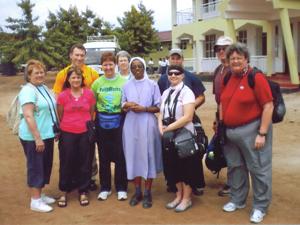
By Janey Lamborn
(Editor’s note: Janey Lamborn is a member of St. John the Baptist Parish in Houghton.)
In February, I was among nine individuals who participated in a mission trip to Tanzania, Africa. The mission team was sponsored by Faith Lutheran Church in Andover.
Although the mission was sponsored by a Lutheran church, four members of the team were Roman Catholic, including me. Other mission team members were Pastor Shannon Witt, Andover; Tracy and Gary Frahm, Miles; Hudson Wikoff and Maggie Murray, Fulton, Ill.; Jack and Rose Smith, Clinton; and Dr. Sue Erredge, Glendale, Ariz.
The trip’s main purpose was to deliver 20 water treatment units. Each year, millions of children die because of contaminated water. These water treatment units kill the bacteria and parasites, making contaminated water potable. Key people in remote villages have been trained to operate the units and test the water. Each unit is powered by a 12-volt battery and delivered to areas where electricity isn’t available. A small solar panel is used to recharge the battery.
We also delivered more than 200 pairs of children’s shoes and school supplies, dozens of tie-dyed shirts that Dr. Erredge’s office staff purchased for the Tanzanian children, small rubber balls, footballs, soccer balls and soap, two small air pumps for inflating the balls, and dozens of washable sanitary napkins and cotton underpants for girls and women.
One of the first mornings after we arrived, our mission team was awakened by the sound of loud chanting and singing. It was a major Muslim holy day called Mawlid an – Nabi, which celebrates the birth of Muhammad.
The mission team was invited to visit and tour Sister Scholastica’s School for Girls which is undergoing construction near Moshi. When completed, it will house 400 girls. Seventy girls have been admitted and are attending classes in four completed classrooms. They come from throughout Tanzania and must pass an examination to be admitted.
When the mission team arrived, the girls were eating lunch that had been prepared outdoors in large pots over a charcoal fire because the kitchen hasn’t been completed. The girls sat on rocks and on the ground eating rice and beans on plastic plates.
We toured a building containing sleeping quarters: one room had bunk beds for 40 girls; an adjacent room was filled with thin pallets on the concrete floor for more girls. Sr. Scholastica and four other nuns share a room and sleep on folding cots.
The mission team had hoped to place a water treatment unit at this school, but the project is on hold because of a funding shortage. An additional $15,000 is needed for a pump, large holding tank and other plumbing supplies. For now, the school purchases bottled water.
In a visit with the bishop of the Pare Diocese, Bishop Charles Mjema in Same, we were asked to deliver our supply of shoes to children designated as Most Vulnerable Children (MVC). We distributed the shoes in Same and Maore.
The mission team then traveled to the village of Maore in the Pare Mountains. Pastor Rose Mufuko, the pastor of Faith Lutheran’s sister church, had been recently assigned there. But she also is responsible for leading worship services each month at 11 preaching points. We traveled to all 11 sites, most in the remote areas where the Maasai tribes live.
The Maasai live in huts made of twigs, sticks and grass. Women construct the houses. Men build protective fences, made of acacia thorns, encircling the house. They also build corral-like enclosures of acacia thorns for their cattle and goats. At night the animals are herded into the enclosures to protect them from predators. Herding the livestock, cattle and goats is the job of the children. During the dry season, the animals must be herded long distances in order to find grass for grazing.
The diet of the Maasai people consists mainly of milk, meat and blood from the cattle. A vein of the cow is punctured, and as much as two liters of blood is drained from the cow and consumed. The cow is not harmed by this procedure and the people still have the milk-producing cow. Blood is a source of protein.
On Sunday morning, Pastor Witt gave a sermon. As she spoke, Pastor Mufuko’s husband served as translator. Those in the congregation who did not have money to put in the collection plate brought various items to the back door of the church, including: eggs, vegetables, bamboo poles, a live chicken, a shirt, bag of rice, a bag of charcoal, a dishpan and bundles of firewood. After the church service, everyone went outside and the items were auctioned off. The money gained from the sale was ceremoniously added to the collection plate.








